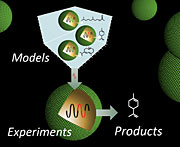- Number 354 |
- January 16, 2012
CAD-like tools for designing RNA and novel organisms

CAD for RNA (Image after
Zosia Rostomian, Berkeley Lab)
Scientists at DOE’s Joint BioEnergy Institute (JBEI), a scientific partnership led by Lawrence Berkeley National Laboratory and including Sandia and Livermore National Labs, the University of California at Berkeley and Davis, and the Carnegie Institution for Science, have developed biochemical models and simulations similar to the computer-assisted design (CAD) programs used by engineers. The new CAD-like tools make it possible to construct RNA devices that can control genetic expression in microbes, with enormous potential for advanced biofuels, biodegradable plastics, therapeutic drugs, and a host of other goods now derived from petrochemicals.
To a synthetic biologist, a living thing resembles an integrated circuit, packed with cellular structures and chemical processes analogous to a microchip’s transistors, resistors, capacitors, inductors, amplifiers, and other microgadgets. Thus it would seem relatively easy to design simple organisms, or redesign them, for novel purposes like producing valuable chemical products from simple, inexpensive, and renewable feedstocks.
In fact, the relations among molecular reactions in a biochemical pathway are so dense, with so many interconnections, that it’s difficult to make sense of what happens when the tangled networks are modified. What’s been missing are adequate tools to understand cellular biochemical networks and then lay them out, tools like those electronics engineers use to design integrated circuits.
“Biological systems exhibit functional complexity at multiple scales,” says Berkeley Lab’s Jay Keasling, director of JBEI. “A big question has been whether effective design tools can be created to increase the sizes and complexities of the microbial systems we engineer to meet specific needs. Our work demonstrates the potential,” he says, promising “rigorous, design-driven engineering strategies for biology.”
“Ultimately we’d like to develop CAD platforms for synthetic biology that rival the tools found in more established engineering disciplines,” says James Carothers, a UC Berkeley member of JBEI and the California Institute for Quantitative Biosciences. “We see this work as an important technical and conceptual step in that direction.”
Keasling, Carothers, and their colleagues focus their design-driven approach on RNA sequences that can fold into complicated three-dimensional shapes, called ribozymes and aptazymes. Like proteins, ribozymes and aptazymes can bind metabolites, catalyze reactions, and act to control gene expression in bacteria, yeast, and mammalian cells.
The researchers developed mechanistic models of biochemical function and simulations of RNA folding, and used them to design 28 specific ribozyme and aptazyme genetic-expression devices for E. coli bacteria, devices with measurably predictable functions. Upon verification, the devices showed 94-percent correlation between predicted and measured gene expression levels.
The JBEI researchers report on their work in the 23 December, 2011, issue of Science. They are now using their CAD-type models to help them engineer metabolic pathways that will increase microbial fuel production. A key to JBEI’s success will be the engineering of microbes that can digest lignocellulosic biomass to sugars and synthesize transportation fuels that can replace gasoline, diesel, and jet fuels in today’s engines.
“In addition to advanced biofuels, we’re also looking into engineering microbes to produce chemicals from renewable feedstocks that are difficult to produce cheaply and in high yield, using traditional organic chemistry technology,” Carothers says.
JBEI is one of three DOE Bioenergy Research Centers established by DOE’s Office of Science to advance the technology for the commercial production of clean, green and renewable biofuels.[Lynn Yarris, 510.486.5375,
lcyarris@lbl.gov]
